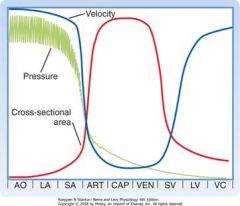![]()
![]()
![]()
Use LEFT and RIGHT arrow keys to navigate between flashcards;
Use UP and DOWN arrow keys to flip the card;
H to show hint;
A reads text to speech;
13 Cards in this Set
- Front
- Back
|
What does the velocity, pressure, cross sectional area graph look like for AO -> capillaries -> vena cava and all vessels in between?
|

AO - Velocity /\, CSA \/, Pressure /\
Cap - Velocity \/, CSA /\, Pressure \/ VC - Velocity \/, CSA \/, Pressure \/ \/ |
|
|
How do you calculate compliance and what is it?
|
the ability of a vessel to stretch to accomodate increased volume and pressure
C = delV/delP = SV/PP SV = stroke volume PP = pulse pressure |
|
|
What does compliance do to peak pressure during systole?
|
reduces peak pressure during systole, but does not change mean pressure
|
|
|
What is capacitance?
|
the ability of a vessel to store blood when compliance increases.
|
|
|
What is the general relative capacitance of the venous system compared to the arteriole system?
|
arteries - \/ compliance, \/ capacitance
veins - /\ compliance, /\ capacitance |
|
|
What is the difference between the pulse pressure and the mean pressure?
|
pulse pressure is affected by compliance of arteries and change of arteriole volume during cardiac cycle
mean pressure is the average pulse pressure over time that is calculated with cardiac output and peripheral resistance. |
|
|
What is the relationship between PP and SV and Compliance (C)?
|
PP = SV/C
|
|
|
What is the relative distribution of fluid volume in the cardiac system?
|
look it up, sucka
|
|
|
What is PVR and how do you calculate it?
|
pulmonary vascular resistance which is anaologous to TPR.
PVR = (MPA - LAP)/CO MPA = mean pulmonary artery pressure LAP = left atrial pressure |
|
|
How do you calculate pulmonary compliance (Cpulm)?
|
Cpulm = (CO/HR)/(SysPulm - DiasPulm)
=R ventricular SV(delV)/delP |
|
|
What is the relative resistance and compliance of the pulmonary circuit when compared to systemic?
|
pulmonary is \/ resistance /\ compliance so that Qpulm = Qsys
|
|
|
If CO = 5 L/min
HR = 50 bpm Pao = 150/90 mmHg Pra = 10 mmHg Calculate MAP, TPR, SV, C and what is the problem is CO is normal? |
MAP = Pdia+1/3(PP)
= 90+60/3 = 110 mmHg TPR = MAP/CO = 110/5 = 22 SV = CO/HR = 5/50 = 1/10 C = SV/PP = (0.1)/60 = really tiny hypertensive, decreased SV because of increased afterload due to decreased compliance and increased pressure |
|
|
A 77 year old woman has aortic pressure of 150/60 mmHg her HR and CO are normal. Calculate her MAP and PP. What's wrong w her?
|
MAP = Pdia+1/3PP
=60+90/3 = 90 PP = 90 PP is increased and MAP is increased because of decreased compliance |

